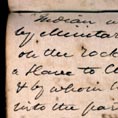
For Educators: Teaching Units & Lesson Plans:
Politics & Diplomacy
Lesson Plan 4: The Shoshone Encounter—A Different Story
OBJECTIVES
Students will:
- listen actively to the reading of a story
- recall key events from the story and retell it orally
- compare and contrast the Teton Sioux encounter with the Shoshone encounter
MATERIALS
| IMAGE | |
| TEACHER READING |
|
| ACTIVITY SHEET |
OPENING
Read excerpt of Biddle's interview with Clark in which Clark describes Sacagawea's meeting with Cameahwait:
Saturday, August 17, 1805: From Biddle's Interview with Clark
 On setting out at seven o'clock, Captain Clarke with Chabonneau and his wife walked on shore, but they had not gone more than a mile before Clarke saw Sacajawea, who was with her husband 100 yards ahead, began to dance and show every mark of the most extravagant joy, turning round him and pointing to several Indians, whom he now saw advancing on horseback, sucking her fingers at the same time to indicate that they were of her native tribe.... We soon drew near to the camp, and just as we approached it a woman made her way through the crowd towards Sacajawea, and recognizing each other, they embraced with the most tender affection. They had been companions in childhood. In the war with the Minnetarees they had both been taken prisoners in the same battle...till one of them had escaped from the Minnetarees, with scarce a hope of ever seeing her friend relieved from the hands of her enemies.... While Sacajawea was renewing among the women the friendships of former days...Captain Clarke...was received by Captain Lewis and the chief .... After this the conference was to be opened, and glad of an opportunity of being able to converse more intelligibly, Sacajawea was sent for; she came into the tent, sat down, and was beginning to interpret, when in the person of Cameahwait she recognized her brother; She instantly jumped up, and ran and embraced him, throwing over him her blanket and weeping profusely: The chief was himself moved, though not in the same degree. After some conversation between them she resumed her seat and attemped to interpret for us, but her new situation seemed to overpower her, and she was frequently interrupted by her tears. After the council was finished the unfortunate woman learnt that all her family were dead except two brothers, one of whom was absent and a son of her eldest sister, a small boy, who was immediately adopted by her.
On setting out at seven o'clock, Captain Clarke with Chabonneau and his wife walked on shore, but they had not gone more than a mile before Clarke saw Sacajawea, who was with her husband 100 yards ahead, began to dance and show every mark of the most extravagant joy, turning round him and pointing to several Indians, whom he now saw advancing on horseback, sucking her fingers at the same time to indicate that they were of her native tribe.... We soon drew near to the camp, and just as we approached it a woman made her way through the crowd towards Sacajawea, and recognizing each other, they embraced with the most tender affection. They had been companions in childhood. In the war with the Minnetarees they had both been taken prisoners in the same battle...till one of them had escaped from the Minnetarees, with scarce a hope of ever seeing her friend relieved from the hands of her enemies.... While Sacajawea was renewing among the women the friendships of former days...Captain Clarke...was received by Captain Lewis and the chief .... After this the conference was to be opened, and glad of an opportunity of being able to converse more intelligibly, Sacajawea was sent for; she came into the tent, sat down, and was beginning to interpret, when in the person of Cameahwait she recognized her brother; She instantly jumped up, and ran and embraced him, throwing over him her blanket and weeping profusely: The chief was himself moved, though not in the same degree. After some conversation between them she resumed her seat and attemped to interpret for us, but her new situation seemed to overpower her, and she was frequently interrupted by her tears. After the council was finished the unfortunate woman learnt that all her family were dead except two brothers, one of whom was absent and a son of her eldest sister, a small boy, who was immediately adopted by her.
Ask students how they think the fact that Cameahwait was Sacagawea's brother affected the diplomatic success of the encounter between Lewis and Clark and the Shoshone.
PROCEDURE
- Read the short narrative of the Lewis and Clark/Shoshone encounter to the students. (Adapted from Ronda.)
- After reading, have students discuss and list key events on a chart.
- Have students work in pairs, retelling the Shoshone narrative orally to each other.
- Debrief by discussing the following questions:
- how much time was there between these two encounters?
- which of these encounters ended with cooperation between the Corps and the tribe?
- which of these encounters ended with increased conflict between the Corps and the tribe?
- did Lewis and Clark use the same four strategies with both tribes?
- what were some similarities in both encounters?
- what were some differences between the two encounters?
- were any of the strategies that Lewis and Clark used successful with both groups?
- do you think that Lewis and Clark got better at diplomacy with time and experience?
CLOSING
Ask students to write a statement about what they think made some strategies more successful than others. Share.
SUGGESTED FORMATIVE ASSESSMENT
Have each student construct a Venn diagram comparing the Teton Sioux encounter with the Shoshone encounter. Teacher could also expand this discussion to focus on what happens when two cultures meet. What things change first?